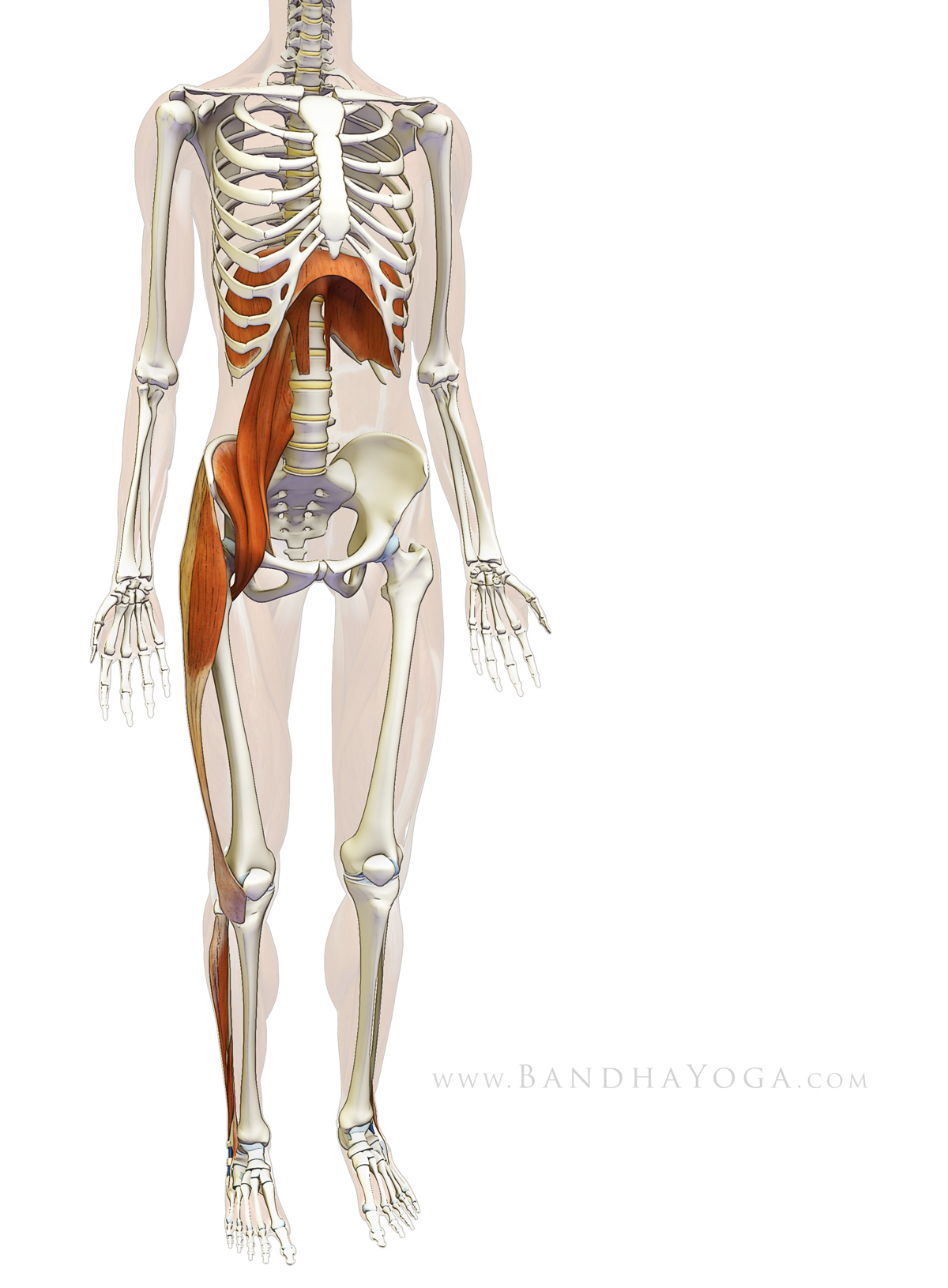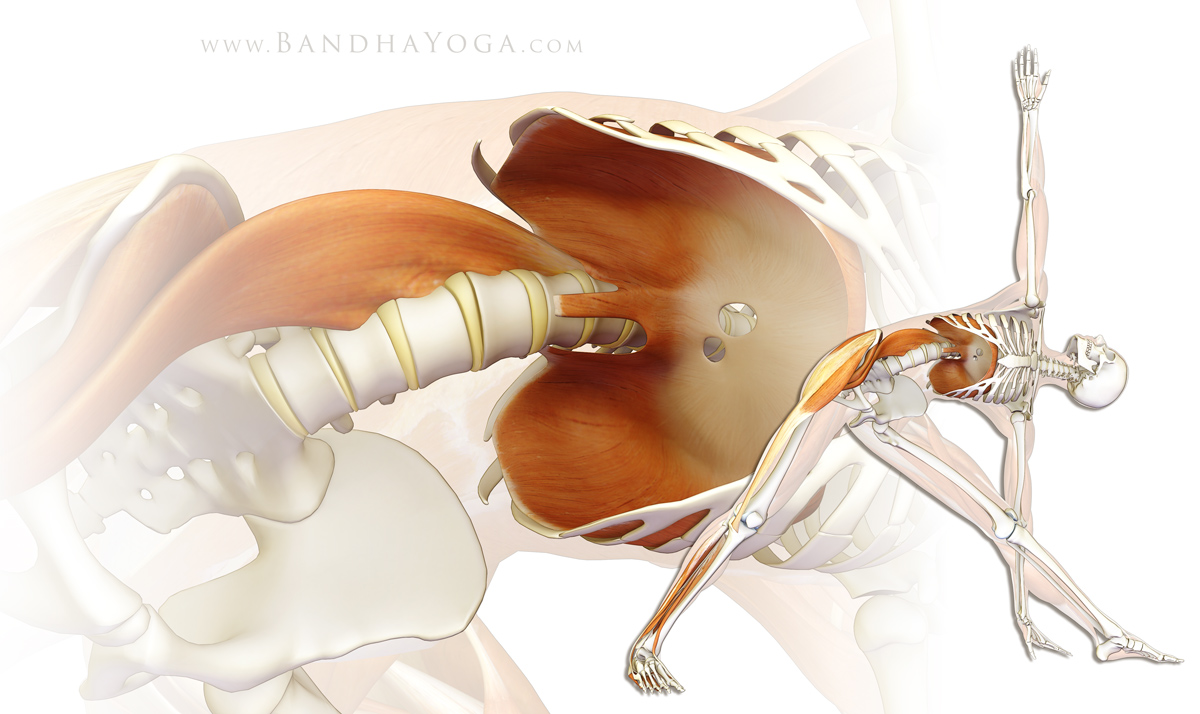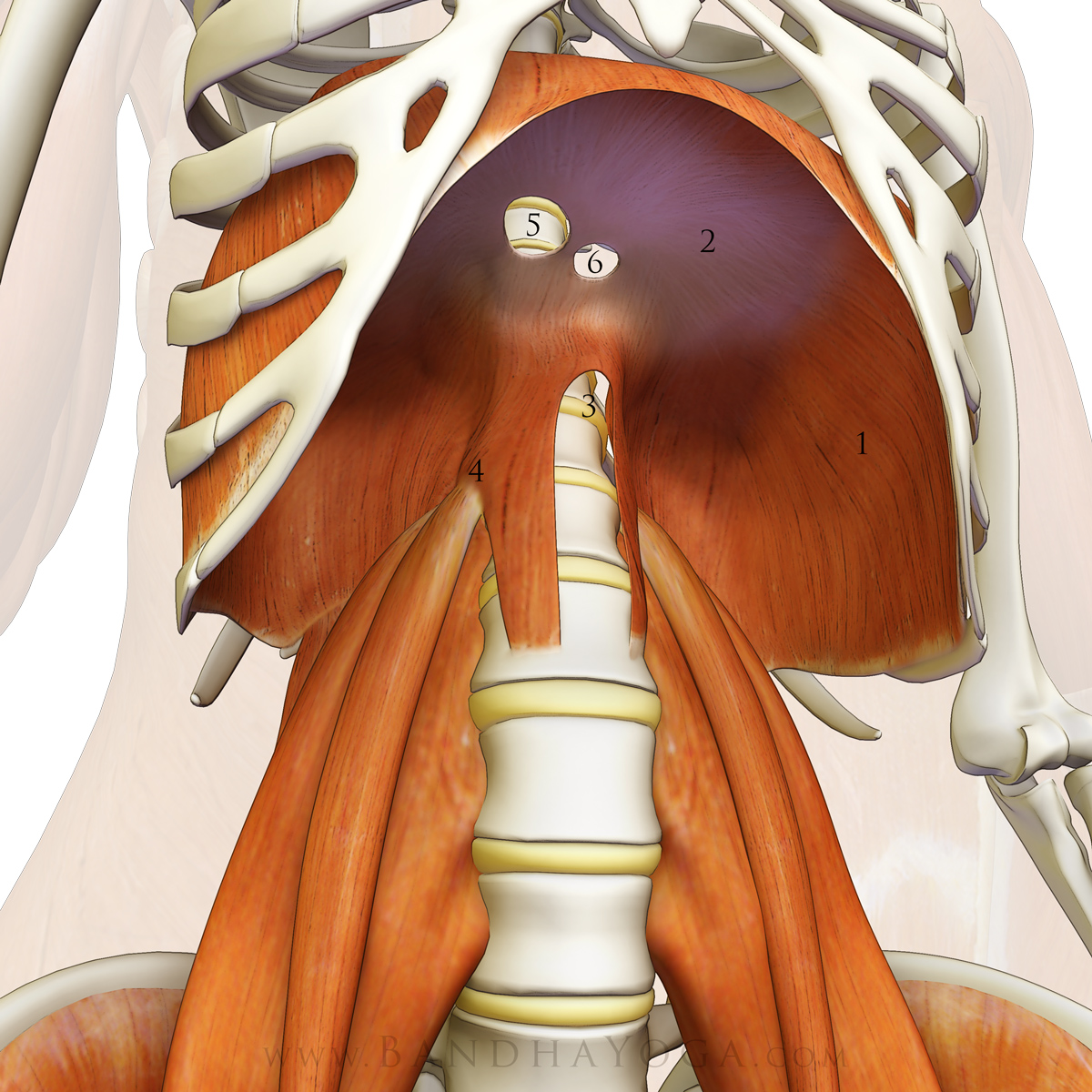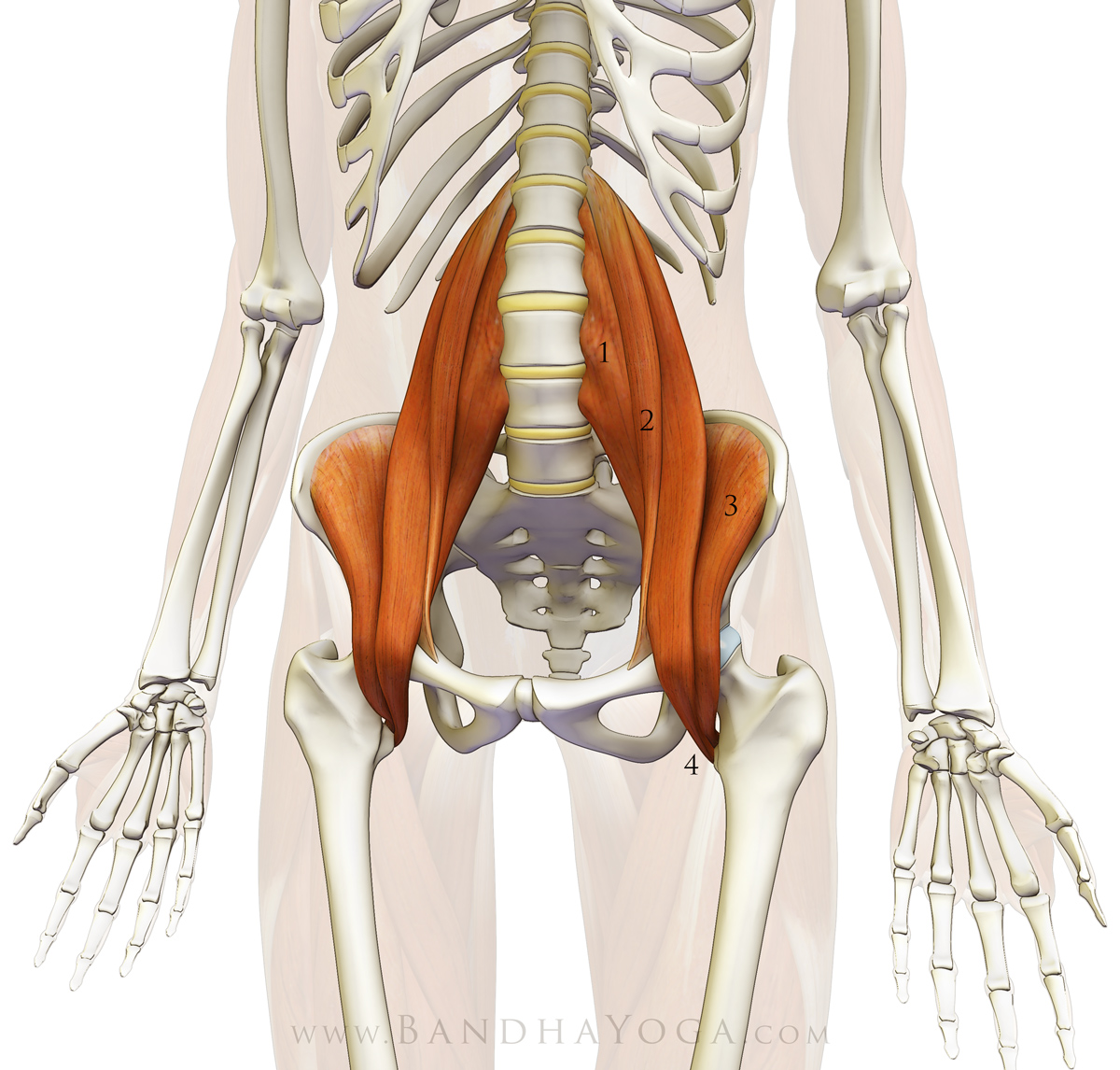 |
| 図1:横隔膜、腸腰筋と下肢の筋膜のつながり |
横隔膜は呼吸の中心となる筋肉です。横隔膜はほとんど無意識で働きますが、意識的にその収縮の速度や強さに影響を与えることができます。呼吸の中心的な役割を担う横隔膜は、私たちの生命力、そして感情やエネルギーレベルの身体と密接に係わっています。ヨガアーサナの練習は、特に腸腰筋の動きに関連して、横隔膜に微細な影響を与えます。ポーズによって横隔膜に与える影響は微妙に違うため、エネルギーレベルのつながりも少しずつ異なったものになります。
 |
| 図2:トリコナーサナにおける横隔膜、腸腰筋と下肢の筋膜のつながり |
視覚化は、これらのつながりにアクセスするための強力なツールです。解剖学や生体力学の詳しい説明の前に、先に述べた筋膜のつながりを示した図1と2をリラックスして眺めてみましょう。イラストを見て、それを身体の中にイメージします。この練習を5秒~10秒間行い、それを2、3回繰り返します。そしてそのイメージを体内で繊細に感じてみましょう。解剖学と生体力学の説明に進む前にこのプロセスを完了してください。
では解剖学的な説明に入りましょう・・・
胸部の横隔膜は、胸腔と腹腔の仕切りとなる半ドーム型の筋肉です。この筋肉の収縮部は末梢に位置し、腱中心(骨に付着していない)につながっています。横隔膜の起始は、肋骨と腰椎に分かれています。肋骨部は、第7~12肋骨・肋軟骨の内面から起始しています。腰椎部には内側(正中線に近い方)と外側(正中線から遠い方)があります。内側は第1~3腰椎の前面から起始し、外側は3つの腱弓から起始しています。一つ目の腱弓は腹部大動脈とつながり、二つ目と三つ目はそれぞれ大腰筋と腰方形筋とつながっています。図3はその構造を示しています。
 |
| 図3:横隔膜と腸腰筋のつながり 1)横隔膜 2)横隔膜腱 3)大動脈裂孔 4)弓状靭帯 5) 大静脈孔 6) 食道裂孔 |
声門を開きながら横隔膜を収縮させると、胸郭が広がり、胸腔内圧が下がって圧力の差が生まれます。陰圧呼吸により空気が肺に引き込まれると、圧力が均等になります。こうした圧力差の変動は、血流を促し、特に静脈から心臓へ血液が戻る流れを促進します。
逆に声門が閉じた状態で、息を吐いた後に横隔膜を収縮させても(ナウリのように)、圧力の差は生まれます。この場合、胸腔内の陰圧が呼吸を引き込む代わりに内臓を上に引き上げます(腹部が中に引っ込む)。声門を閉じ、息を吐いて横隔膜を収縮させる動きは、筋肉が長くなりながら収縮する遠心性収縮です。
息を吐きながら腹筋を収縮すると、腹腔内圧が上がり、内蔵が上方に引き上げられるため、受動的に横隔膜が伸ばされます。また、息を吐きながら腹筋を収縮させると胸腰筋膜も収縮するため、腰椎と仙腸関節が安定します。この働きの詳細については、こちらをご参照ください。
大腰筋は、浅部は第12胸椎と第1~4腰椎(外側面および椎間板)から起始し、深部は第1~5腰椎(肋骨突起)から起始しています。大腰筋は、腸骨の内側(腸骨窩)から起始する腸骨筋と合流して腸腰筋となります。腸腰筋は、骨盤前面の縁をまたいで、大腿骨(太ももの骨)の内側上方にあるノブのような形の小転子に停止します。腸腰筋は2つ以上の関節をまたいでいるので、多関節筋に分類されます。腸腰筋の片方だけを収縮すると、大腿骨を屈曲、外旋し(あるいは)、トリコナーサナのように体幹を側屈、もしくは骨盤の片方を前方に傾けます。腸腰筋を左右を同時に収縮すると、大腿骨と体幹の両方が屈曲します。仰向けの姿勢でこの筋肉を左右同時に収縮させると、体幹が上方に持ち上がります。図4は、腸腰筋のイラストです。腸腰筋を独立させて目覚めさせ、ヨガのポーズでこの重要な筋肉を意識的に使うためのテクニックをみてみましょう(こちらをクリック)。
 |
| 図4:腸腰筋 1)大腰筋 2)小腰筋 3)腸骨筋 4)腸腰筋(腱が小転子に停止) |
さて、もう一度、横隔膜、腸腰筋、下肢の筋膜のつながりのイメージ(図1と図2)に戻りましょう。リラックスしてこれらの構造をしばらく眺めます。最初に見た時と、今見るまでの短い時間に、身体の気づきがどのように深まったか感じてみましょう。このプロセスを日々の練習に取り入れてください。
スワミ・サテャナンダ師が述べているように、サンカルパと想像力を使った視覚化は、ヨガニードラの8つの構成要素の2つにあたります。視覚化と意志の誓いは、通常アーサナの練習の深いリラクゼーションの時に行われますが、アーサナの練習中に行うこともできます。スワミ・サラスワティ師は、サンカルパのプロセスを広い川を渡るための飛び石に譬えて美しく表現しています。
私の著書は、このような視覚化の経験につながるようにデザインされています。長年にわたる解剖学と生体力学の専門的な研究に基づいた内容に合わせて、脳の視覚野を刺激して各ポーズで使われる筋肉が活性化できるように、注意深くデザインされたイラストが使われています。多くのヨガ練習生が、「図解YOGAアナトミー・骨格編」および「図解YOGAアナトミー・アーサナ編」を見ていると筋肉が実際に「感じられる」とコメントしています。「マット・コンパニオン・シリーズ」では、段階的にポーズにアプローチすることで、視覚化の経験をさらに深めることができます。このような視覚化の体験は、あなたのアーサナ練習の改善につながるでしょう。こちらをクリックして、これまで出版された著作をご覧ください。
ブログを読んでくれてありがとう!ぜひFacebookやTwitter、Google Plusでシェアしてください!
レイとクリスより

gracias por ten excelente articulo, quisiera saber si el material que venden esta traducido al español,namaste,luna
返信削除Muchas gracias Nelida - estoy encantado que le guste nuestro trabajo! Usted puede encontrar nuestros libros en español en:
削除http://www.editorialacanto.com/index.php?cat=15&cate=Yoga
Ramon
You offer so much valuable information! Thank you -- I share it all with my yoga students and yoga teacher trainees!
返信削除Great to hear, Peggy. Thank you for sharing it with your students and trainees!
削除Namaste'
Ray
impresionante artículo! Gracias por compartirlo!
返信削除Gracias Siempreverde! Ramon
削除Your workshop in Costa Rica only will be in english? could be with translation in spanish?
返信削除Hola Siempreverde! Thanks for stopping by. The workshop in Costa Rica is in English. I speak some Spanish, but not enough to give a workshop. We are planning a future workshop in Argentina, where we will have a translator. Best~Ramon
削除Hi, when in Argentina??
返信削除Hi Carola,
削除We don't have a date set on Argentina yet; we'll announce it on the website once it is confirmed. Best~Ray
Any chance of you coming to South Africa? Cape Town?
返信削除Hello Gerda,
削除I would love to come to Cape Town at some point. If you know a school that is interested, please have them contact my assistant Carol@bandhayoga.com and we'll arrange it. All the Best~Ray
Thank you so much for sharing this here, as I am too far away to attend the workshops. I really enjoyed reading this article and look forward to seeing your pictures and thoughts about the knee. Namaste
返信削除Thanks Anon--delighted that you enjoy the articles! Ray
削除I'm in heaven...this is so beautiful! I will see you in North Carolina next year - I believe in May
返信削除Thanks so much for sharing your wisdom.
My pleasure Ana, many thanks for your compliment on our work! This keeps us going. look forward to seeing you in NC~Ray
削除A big Thank you for your generosiy in sharing this information wiht us all!!!, I too am too far away to be able to attend the workshops. I really appreciate reading your articles and look forward to seeing your pictures. Namaste c
返信削除Thank you, Anon! Namaste'~Ray
削除Thanks for sharing such informative topics. Great.
返信削除You're welcome Yoga Guru! Ray
削除very useful!thank you
返信削除Thanks Alexandra! Ray
削除Hi Ray
返信削除I am new to yoga but love it. I am wondering if a beginner in yoga would struggle in the workshop?
Thanks
Hello Kath,
削除We have beginners to "advanced" practitioners in our workshops. I tailor the asanas to the individuals, everyone learns. Hope to see you! Ray
I have been practicing Yoga off and on for a long time. I love your blog and the beautiful anatomy illustrations. They are extremely helpful and motivated me to buy your books and restart practicing Hatha Yoga.
返信削除I recently had total hip replacement and because many of the tendons and ligaments to the head of the femur were cut, I cannot perform many of the old asanas that I used to do for fear of popping out the hip joint. I showed my surgeon some illustrations of asanas and asked if I could do these again... His response was "On purpose?"
But in all seriousness, there is a growing segment of the population (like me) who are older and could benefit from Yoga. Can you do some posts or even a book on dealing with joint replacement in practice and how to strengthen the areas so one can do a more full Yoga workout?
Hi Stephen,
削除Thanks for stopping by. Ask your doc to advise you on the surgical approach he used to replace your hip, the range of motion he recommends and the limitations (partly based on the surgical approach). Tell him the pictures are of yoga, an ancient art that is practiced around the world by millions of people--on purpose (with purpose) to enhance their lives in many ways. You can mention that the American Academy of Orthopedic Surgeons has cited it as one of the adjuncts for conservative management of knee arthritis and you would like to return to it so you can avoid having him replace your knee...:)
Thanks for the suggestion on a post. It's a bit complex and depends on the individual hip replacement (with a number of factors), so I usually tell people to follow their docs restrictions on range of motion and use common sense on which poses they work with. See my blog post on balancing freedom and restraint in yoga. All the Best and good luck on returning to practice! Ray
I wait 4 you soon in Argentina! Thanks 4 this excellent info; are you annoucing in this news letters when are you coming?
返信削除Hi Willie,
削除Yes, I will announce when we are coming to Argentina. Thank you for your compliment on our work! Ray
This is excellent, the graphics plus the explanations, I love it, many thanks!!
返信削除Thanks Josune! great to hear that you enjoy our work~Ray
削除Appreciate the initiative and precious information.. Namaste
返信削除Thanks Yoga Plus! Ray
削除Ray, in this post you wrote about the myofascial connection between diaphragm, psoas and lower extremity (TFL and peroneus, according to figure 1??). I agree with diafragm-psoas linkage of course, but I don't understand how is it myofascially connected to the external side of the leg, if they don't belong to the same muscular chain? In Uthittha Trikonasana I think that the linkage is made via obliques muscles. Please, could you explain it better. Thank you very much!
返信削除Hi Esperanza,
削除The abdominal obliques are also connected to the muscles of the lower leg--via the periosteum on the iliac crest to the TFL and thence to the other muscles illustrated (and multiple other muscles). I am showing a connection that is deep to that, and also functional. The TFL is connected, also via the periosteum, to the iliacus. If you look at the function of the obliques in a side bend, like Trikonasana, then you can see that they stretch, as does the psoas major (they are synergists for side flexion of the trunk). The TFL synergizes the obliques and the psoas major when coming up from a side bend like Trikonasana (both via closed chain contraction); indeed the linkage shown here from the TFL to the lower leg should be a focus on when coming up from this pose. Using these muscles when coming out of the pose helps to avoid back strain. I'll show the oblique connection in a future post. Thanks for commenting~Ray
Thank you Ray for the detailed explanation. I'm really interested in fascial topics, I couldn't imagine the conecction of deep fascia and the periosteum, that's amazing. I will follow your future post in the blog. I think that biomechanical and anatomical comprehension is essetial for understanding the 'asana' and performing it the best. Thank you for sharing your knowledge!
削除I wait with baited breath for these postings. They are so helpful and informative for my own practice and have become invaluable in explaining postures and cues for my classes. I have purchased all the books in the series yet, the postings always seem to follow what I'm working with in my practice and help to convey vital yogic anatomy to the students who attend my classes.
返信削除Thanks Ray and Chris...Namaste!
Awesome to hear, John--delighted that you enjoy our work! Many thanks for your positive feedback as what you describe (helping in your practice and teaching) is our goal. Namaste'~Ray
削除Thankyou very much for this beautifully written and very informative article.
返信削除The illustrations are amazing and very helpful also.
Namaste!
This is my second read through. When I purchased some of your books a few years back I recieved a poster of the iliopsoas. I glued it to a poster board and still have it. I am anxious to get home so I can be "awed".
返信削除Your post are really worth taking the time to do several reading sessions. There is so much to take in that the second time through was even greater than the first!!!
You WOW us in the way you inform!!! Thanks so much...